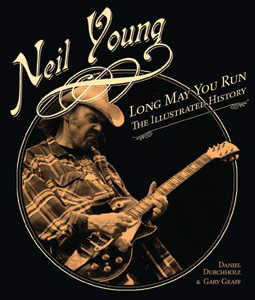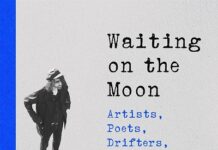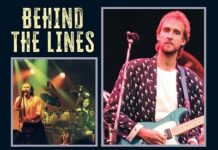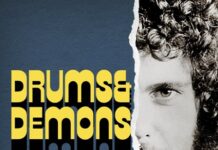Of the countless books and diatribes written about Neil Young, Neil
Young ~ Long May You Run: The Illustrated History is about as a complete
and up-to-date as you could ask for. Intricately decorated with a range of photos,
album art, posters, ticket stubs, backstage passes, colorful drawings, and other
such swag, this 200-plus-page tome to all things Neil Young may look good on
the coffee table, but is liable to end up in the reading room as a hardy rock
and roll reference.
The steady narrative, written by renowned rock journalists Daniel Durchholz
(Rolling Stone) and Gary Graff (New York Times), is laced
with chunky quotes from innumerable sources, including Young himself, mostly
from PBS and Jimmy McCullough’s Shakey, the 2003 biography
initially written in collaboration with the singer. That book would
later become the center of a legal dispute between the author and its subject,
described, like so many cataclysmic events in Young’s career, in a detailed
sidebar in this book.
Young’s formative years get a thorough ringing with photos from his childhood,
school life and early bands. We learn that Young’s father, Scott, was
a well-known sports journalists and writer. We also learn that his mother Rassy
was a panelist on a TV quiz show called Twenty Questions. It would
seem his parents break-up would have little effect on his music, aside from
his parents themselves disagreeing on Young’s career choice. Later, Young’s
father becomes his son’s biggest fan.
There’s a side-trip with the future Rick James and the Motown-bound Mynah
Birds, and then the birth of Buffalo Springfield, which occurred when Young
and Bruce Palmer went to L.A. in search of Stephen Stills. Plenty of photos,
singles cover art and concert posters grace the pages, as the group’s
odd, short ascent is laid out. Even as Buffalo Springfield gained a foothold,
Young was building bridges for a solo career.
One of his first moves after leaving the group, as it is told in one sidebar,
was to seek the assistance of Elliot Roberts, his manager to this day. In another
sidebar, we get insight into Young’s creative relationships with three
producers — Jack Nitzsche, David Briggs, and Niko Bolas. Suddenly, the
floodgates open, and Young’s solo career, beginning with The Gold
Rush 1968-1972, is explored. This period may go down as Young’s most
prolific, as he recorded four solo albums and one with Crosby, Stills and Nash.
Along the way, we meet the Rockets (aka Crazy Horse) and Old Black (Young’s
1953 Les Paul).
Young’s development as a singer, songwriter and recording artist is also
well chronicled — at one point, exploring the so-called feud with Lynyrd
Skynyrd, the making of the highly political song “Ohio,” and then
noting an appearance on the Johnny Cash Show. All in a day’s work for
Neil Young, it would seem. More single cover art from around the world and a
journey through the past later, and the mid 70s set in.
This was a time of loss for Young, beginning with the death of Crazy Horse
guitarist Danny Whitten. Through the grieving of Whitten and roadie Bruce Berry
— both victims of drug overdose — Young wrote and recorded some
of his greatest records, notably Tonight’s The Night,
released two years after it was recorded and, according to Young, “like
an OD letter.” Through all the carnage, Young cranked it out on all fronts.
One sidebar reveals the details behind his foray into motion pictures, starting
with the never-released-because-it-was-never-made After The Gold Rush
and ending with CSNY/ Déjà Vu, the Shakey-directed film
about the 2006 Freedom of Speech tour with Crosby, Stills, Nash and
Young.
Young kept a rigid pace until the end of the decade, reassembling Crazy Horse,
recording with Stephen Stills (but ditching the subsequent tour after two weeks).
The women who have collaborated with Young — Emmylou Harris, Nicolette
Larsen, Linda Ronstadt, sister Astrid Young and wife Pegi Young — each
rate a paragraph or two. Rust Never Sleeps finished the 70s
on a high note, which, at the time, led many to believe Young would mount a
new revolution in the 80s. They couldn’t have been more wrong.
The very first sentence of Transformer Man 1980-1988 refers to the
80s as the “lost decade” for Neil Young. For the singer-songwriter,
his priorities merely changed. Both his sons suffer from cerebral palsy, which
the book says dramatically impacted his music. The quirky experiments with synthesizers
and samples definitely threw everyone expecting “Heart Of Gold”
for a loop. Complicating matters, he wasn’t making the kind of albums
his record company wanted, which lead to a widely publicized feud with mogul
David Geffen. Through it all, Young and Crazy Horse continued to grind it out.
So much so, that by the 90s, they were credited as the inspiration for a new
musical movement called grunge. Ragged Glory would capture
Young and the Horse at their most vicious. Young went acoustic after that, recording
Harvest Moon, the so-called “follow-up” to Harvest.
The grunge factor, dealt with extensively here, crept back in. There was 1994’s
“Sleeps With Angels,” an ode to the dearly departed Kurt Cobain,
who quoted Young’s lyric “it’s better to burn out than to
fade away” in his suicide note. Then, the next year, a collaboration with
Pearl Jam on Mirror Ball. The posters and magazines from this
period featured in the book are especially eye-catching.You may be, at some
point, tempted to even cut them out and display them in your home. You’ll regret
it later.
For the rest of the 90s, Young and Crazy Horse kept up a steady gallop. By
the turn of the decade, CSNY hit the road for the first of three tours over
the next six years. Young traversed between solo acoustic albums and a funky,
upbeat mixed bags of coconuts. Greendale, Living With
War, right through the Archives — the works
of Neil Young are cracked open and exposed for what they are. A detailed discography,
with each album cover, fills in the gaps. Hardcore fan or casual admirer —
Neil Young ~ Long May You Run: The Illustrated History is the
kind of book you’ll return back to time and time again, for reference
or fact, for a glimpse at some of the graphics and photos, or…just for
the hell of it. Long may you run.
~ Shawn Perry




















